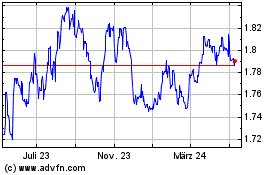Euro Declines On Growth Concerns
05 September 2023 - 1:04PM
RTTF2
The euro weakened against its most major counterparts in the
European session on Tuesday, as weak PMI readings from Europe and
China fueled concerns about slowing global growth.
Final data from S&P Global showed that the euro area private
sector economy contracted the most in nearly three years in
August.
The HCOB composite output index fell to 46.7 in August from 48.6
in July. The initial score was 47.0 for August.
The services Purchasing Managers' Index, or PMI, posted 47.9,
down from 50.9 in July. Moreover, the pace of decline was the
steepest since February 2021. The score was also below the initial
estimate of 48.3.
China's services activity expanded at the slowest pace in eight
months in August, a private-sector survey showed earlier today.
The euro touched 1.0716 against the greenback, its lowest level
since June 8. The euro is seen finding support around the 1.06
area.
The euro declined to 0.9536 against the franc, from an early
high of 0.9552. The euro is likely to find support around the 0.94
level.
The euro eased to 1.8246 against the kiwi and 1.6819 against the
aussie, from an early 5-day high of 1.8319 and near a 2-week high
of 1.6894, respectively. The next possible support for the currency
is seen around 1.76 against the kiwi and 1.65 against the
aussie.
The euro dropped to a multi-week low of 1.4609 against the
loonie, reversing from a previous 4-day high of 1.4702. The
currency is poised to find support around the 1.44 level.
The euro fell to near a 2-week low of 0.8540 against the pound,
down from a prior 5-day high of 0.8576. The currency may face
support around the 0.82 level.
In contrast, the euro rebounded to 158.28 against the yen,
heading to pierce its previous 5-day high of 158.40. If the
currency rises further, 160.00 is likely seen as its next upside
target level.
Euro vs NZD (FX:EURNZD)
Forex Chart
Von Jun 2024 bis Jul 2024

Euro vs NZD (FX:EURNZD)
Forex Chart
Von Jul 2023 bis Jul 2024
